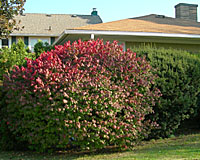Terry L. Ettinger Horticulture Consulting Services
Meeting The Needs Of Today With A Vision For The Future
Question of the Week
How to Prune Burning Bush
 Q. Have you published anything on the care and pruning of burning bushes? I hope so, as mine are growing much too large!
Q. Have you published anything on the care and pruning of burning bushes? I hope so, as mine are growing much too large!
A. Come mid- to late October, it's obvious why burning bush (Euonymus alatus) is among the most popular of all deciduous landscape shrubs - it's because of its absolutely brilliant fall foliage, below left!
 Less obvious reasons for its popularity is that it's extremely easy for nurseries to propagate, grow, and ship.
Once in retail
garden centers, it tolerates quite a bit of abuse (too much water, not enough water, etc.), and it pretty much sells itself
- it's one of
the relatively few shrubs that the public, even those that are non-gardeners, know
and ask for by name!
Less obvious reasons for its popularity is that it's extremely easy for nurseries to propagate, grow, and ship.
Once in retail
garden centers, it tolerates quite a bit of abuse (too much water, not enough water, etc.), and it pretty much sells itself
- it's one of
the relatively few shrubs that the public, even those that are non-gardeners, know
and ask for by name!
 This is all just fine, except for one small problem - burning bush is a huge
shrub when mature. In fact, the specimen at right is only about
two-thirds full grown!
This is all just fine, except for one small problem - burning bush is a huge
shrub when mature. In fact, the specimen at right is only about
two-thirds full grown!
But you planted "dwarf" burning bush (Euonymus alatus `Compactus') along the front foundation of your home, so you're good, right?
Wrong!
 At
left is a picture of my Mom standing to the right of a mature "dwarf"
burning bush a number of years ago at the
Missouri Botanical Garden,
in St. Louis. By the way, Mom is about five feet, five inches tall.
The "dwarf" in `dwarf' burning bush, has nothing to do with the size
of the plant, but rather the small size of the corky ridges along
its stems in comparison to the regular burning bush (at tips of the
arrows in the picture below, at right).
At
left is a picture of my Mom standing to the right of a mature "dwarf"
burning bush a number of years ago at the
Missouri Botanical Garden,
in St. Louis. By the way, Mom is about five feet, five inches tall.
The "dwarf" in `dwarf' burning bush, has nothing to do with the size
of the plant, but rather the small size of the corky ridges along
its stems in comparison to the regular burning bush (at tips of the
arrows in the picture below, at right).
 So, the question becomes, what can you do if the burning bush you've planted
- or nine burning bushes as in the case of the relatively new home below
-
has grown too large for the space in which they're planted?
So, the question becomes, what can you do if the burning bush you've planted
- or nine burning bushes as in the case of the relatively new home below
-
has grown too large for the space in which they're planted?
 One option is to take the hedge shears to
them in early spring. For better, or worse, burning bush is tolerant of very
severe pruning and can, therefore, be sheared into a wide range of squares, rectangles and globes!
One option is to take the hedge shears to
them in early spring. For better, or worse, burning bush is tolerant of very
severe pruning and can, therefore, be sheared into a wide range of squares, rectangles and globes!
 Or, you could think a little "outside the box," and turn your burning bush into small trees by removing
all of the lower branches, at right. In many situations, this could be a very effective - and ultimately quite attractive
option?
Or, you could think a little "outside the box," and turn your burning bush into small trees by removing
all of the lower branches, at right. In many situations, this could be a very effective - and ultimately quite attractive
option?
And, if you're really courageous - or desperate - you might even want to attempt "rejuvenation" pruning. This technique involves cutting the plants all the way back to stubs no more than six to twelve inches from the ground, below left! Providing they're in otherwise good health, they'll gradually recover from this extreme pruning practice over the course of several years.
 Of
course, no matter how you prune your burning bush, they're still going
to continue to grow, and grow, and grow some more!
Of
course, no matter how you prune your burning bush, they're still going
to continue to grow, and grow, and grow some more!
So, a second option could be to transplant them to spots where they can be allowed to grow as large as they want. Unfortunately, many, if not most residential properties simply aren't big enough to contain a full-grown burning bush - without at least occasional pruning, that is.
 Finally, and possibly the best long-term option, is to get rid of the plants, and replace
them with something that will not grow
too large for the space in which they're planted.
Finally, and possibly the best long-term option, is to get rid of the plants, and replace
them with something that will not grow
too large for the space in which they're planted.
A couple of alternatives that grow roughly six feet tall and wide, and feature good to brilliant fall foliage color - along with much better flowers than burning bush, are chokeberry and oakleaf hydrangea.